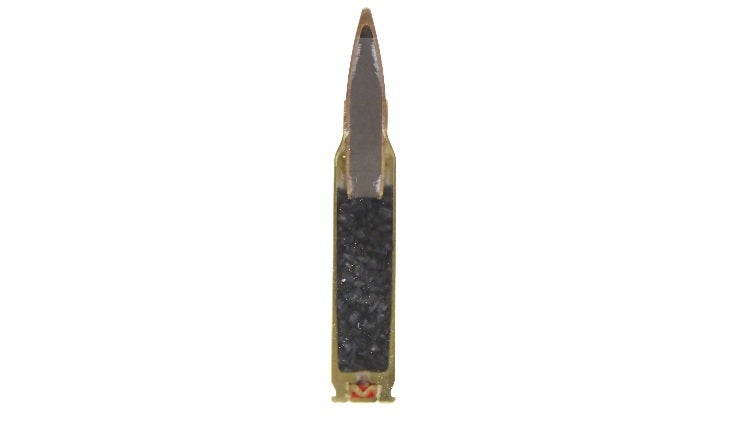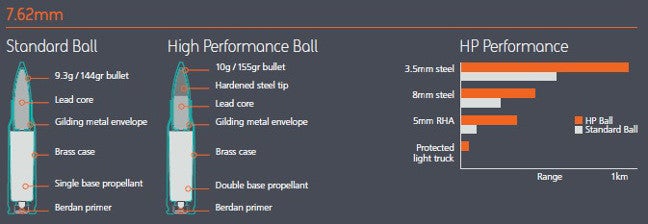It’s not just the Yanks that are getting improved ammunition: Our friends across the pond have developed their own firepower upgrade for 5.56mm and 7.62mm weapons alike. Jane’s has a modest article on the subject, while The Register provides a quite good overview of exactly what the new rounds are and what they mean for today’s Tommy:
The two new designs of cartridge, known as the Enhanced Performance (EP) round in 5.56mm and the High Performance (HP) round in 7.62mm, feature new – and, in the HP’s case, heavier – bullets. In addition, the HP round switches from single-base propellant powder to double-base, to give the heavier bullet the same flight characteristics as the old one. The EP also discards the age-old NATO SS109 bullet design, which incorporates a steel tip in front of a lead core, for an all-steel bullet, cased in the same gilding metal jacket as before. Its profile is similar, though.
BAE Systems’ new 5.56mm Enhanced Performance round, also known as the L31A1
The biggest change for the 5.56mm round is the switch from a two-part bullet, made up originally of a steel tip and a lead core, to an all-steel bullet. While it continues to have a gilding metal jacket (an alloy of 95 per cent copper and five per cent zinc), the departure from the standard SS109 bullet design is relatively radical.
Simon Parker, a project manager at BAE Systems Radway Green, spoke to The Register about the new rounds and the decisions behind the changes in their makeup.
“We wanted to see if we could improve performance against hardened targets. Having a solid hardened steel core improves performance above that of the steel tipped round,” he said. The new 5.56mm round, which will be known as the L31A1 in British service, retains a bullet weight of 62 grains (4g), meaning its ballistic performance will be very similar – an important similarity for soldiers firing it down their SA80 rifles.
…
For the 7.62mm round, known as the L59A1 in British service, the biggest change is to the weight of the bullet, from 144 grains (9.3g) to 155gr (10g). This increased maximum weight allows the new bullet to incorporate a steel tip, similar to the 5.56mm NATO SS109 design, giving it more mass with which to punch through a light target. Graphs from BAE claim that the HP bullet can penetrate an 8mm steel sheet out to about 400m, whereas its predecessor could only manage it at half that distance.

The British Army’s new L31A1 5.56mm round, sectioned to show off its solid hardened steel core. Image credit: Anthony G. Williams.
These new developments from the Isles come on the heels of multiple American improved performance loads for the two calibers, including the US Army’s 5.56mm M855A1 and 7.62mm M80A1 Enhanced Performance Rounds, and the US SOCOM and USMC’s 5.56mm Mk. 318 and 7.62mm Mk. 319 Special Operations Science and Technology rounds. The Australians, too, have introduced their own improved load, the 5.56mm F1A1, which features a much more modest redesign of the projectile from the NATO-standard SS109 round. All of these rounds sport improved propellants derived from the much more thermally-stable design created by St. Marks Powder, Inc, a Florida-based subsidiary of General Dynamics.
The primary difference between the US developments and those abroad is how the configuration of the jacket is interpreted in the context of international law. American military legal counsel holds that a reverse drawn jacket does not constitute “incisions” or “piercings” that would violate the Hague Convention, while British and Commonwealth opinion tends to be that a traditional front-to-back drawn full metal jacket envelope is necessary for true Hague compliance.
 Your Privacy Choices
Your Privacy Choices
